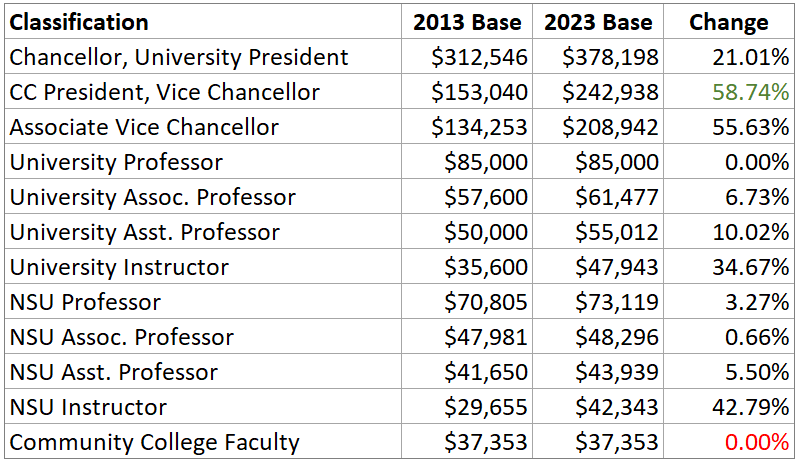It's no secret that salaries for CEOs in private corporations across American have grown at a nearly obscene rate for the past 50 years, while rank and file income growth has all but stalled. A 2022 study by the Economic Policy Institute revealed that CEOs are paid 399 times as much as a typical worker as of 2021. In other words, for every dollar the average worker earns, the boss at the top of the organization's food chain is making nearly $400. That is a massive increase from the 1965 ratio of 20-to-1, or even the 1989 ratio of 59-to-1. The AFL-CIO's annual Executive Paywatch report indicated that this discrepancy is 272-to-1 in S&P 500 companies in 2022. Regardless of which methodology or reporting agency you turn to, the message is clear. The executive class grows ever wealthier while the rank-and-file fall further behind. The disparity has grown so much, it is now a leading cause for labor actions in the country. It appears the same dynamic may be playing out in higher education, and there is anecdotal evidence it is happening in NSHE, albeit on a smaller scale.
This caught my attention at the August 29 meeting of the Board of Regents when Regent Carol DelCarlo questioned the jump in salary for the new Interim Chancellor Patty Charlton compared to the salary of her predecessor, Dale Erquiaga. According to DeCarlo's comments, Erquiaga served as acting chancellor with an annual salary of about $300,000. Less than two months after Erquiaga's departure, Charlton's appointment comes with a salary of $378,198 per year, or an increase of 26%.
NSHE Executive Vice Chancellor and Chief of Staff Crystal Abba explained to the Regents that between the time Erquiaga was hired and the time Charlton was appointed, NSHE paid a consultant to conduct a salary schedule study in compliance with Title 2, Chapter 5, Section 5.5 of the Board of Regents Handbook. The study recommended substantial modifications to several salary schedules, mostly at the executive and administrative ranks. One of those recommendations, which were implemented in July 2022, resulted in the starting salary in Grade 1 of the NSHE Executive Salary schedule to be adjusted upward by 21%. For community college presidents and vice chancellors who are placed on Grade 2 of the same schedule, the starting salary increased by an unprecedented 59%.
A quick check of the changes in NSHE salary schedules over the past decade reveals progress has been inconsistent, to be charitable. We compared schedules from the P&GM as it was published in July 2013 with the July 2023 edition. The table below summarizes the scope of changes for various NSHE professional job classifications.

It's important to keep in mind that the only individuals affected by a change to their salary schedule are those whose current salary falls below the new minimum of the adjusted schedule. These changes primarily affect new employees, which means any new faculty hired at a community college are placed in the exact same starting salary as they were 10 years ago.
And, while it's not a perfect apples-to-apples comparison with our examples from the private sector above, the compensation gap at NSHE, based on the starting point in each salary schedule, is also growing. In 2013, the lowest a Chancellor or University President could be paid was $312,546, which is just over 8 times more than the starting point on the community college salary schedule at $37,353. The new minimum salary at the top of this food chain has grown to $378,198, or more than 10 times greater than the stagnant community college starting point. In essence the gap grows wider. In fairness, a faculty salary is based on 10 months, so adjusting the salary to an annual amount still leaves a gap of 8.5 times in 2023.
Realistically, we have very few faculty members, if any, starting at the bare minimum. That wasn't a living wage in 2013, let alone now. But we do have some that do not earn substantially more than that. It's equally unlikely, however, that our next permanent chancellor or any new president will be paid at the bottom of the scale.
Like Regent DelCarlo, the dramatic increase in the Chancellor's lowest-possible salary took us by surprise, too. It stands to reason that massive and inconsistent adjustments to salary schedules like these would have drawn significant attention when it was presented at a Board of Regents meeting, but no one could recall that happening. It turns out that these modifications were never discussed in the public forum of the BOR meetings. Salary schedules for NSHE employees are published in the NSHE Procedures and Guidelines Manual (P&GM). Unlike the Board of Regents Handbook, which requires all revisions to be approved in a BOR meeting, changes to the P&GM only require a memorandum from the chancellor's cabinet to the Board. Student fees are the one exception, requiring a Board vote for any changes.
The Board will soon discuss changes to a policy in the Handbook, governing the development and review of salary schedules. Fortunately, the policy was not passed at the September 8 meeting of the Board due to a technical snag. It is likely going to come up for a vote again in October. The full policy, itself, creates interesting obligations for NSHE, and we are not sure they have lived up to all of them (more on that in another post). We must encourage the Regents to adopt this proposal with the option that requires all changes to salary schedules to be discussed and voted on in the public forum of Board of Regents meetings. Without such transparency, would it be surprising to learn ten years from now that the gap has grown even wider while no one was looking?